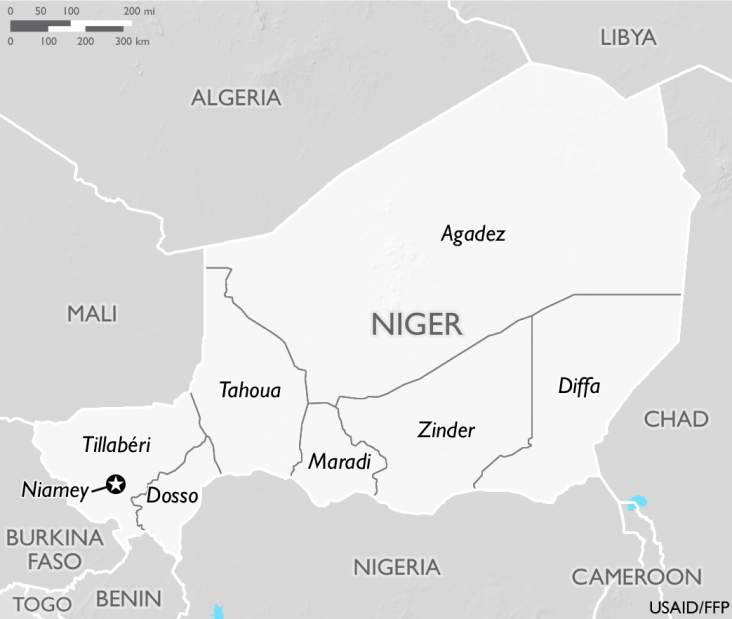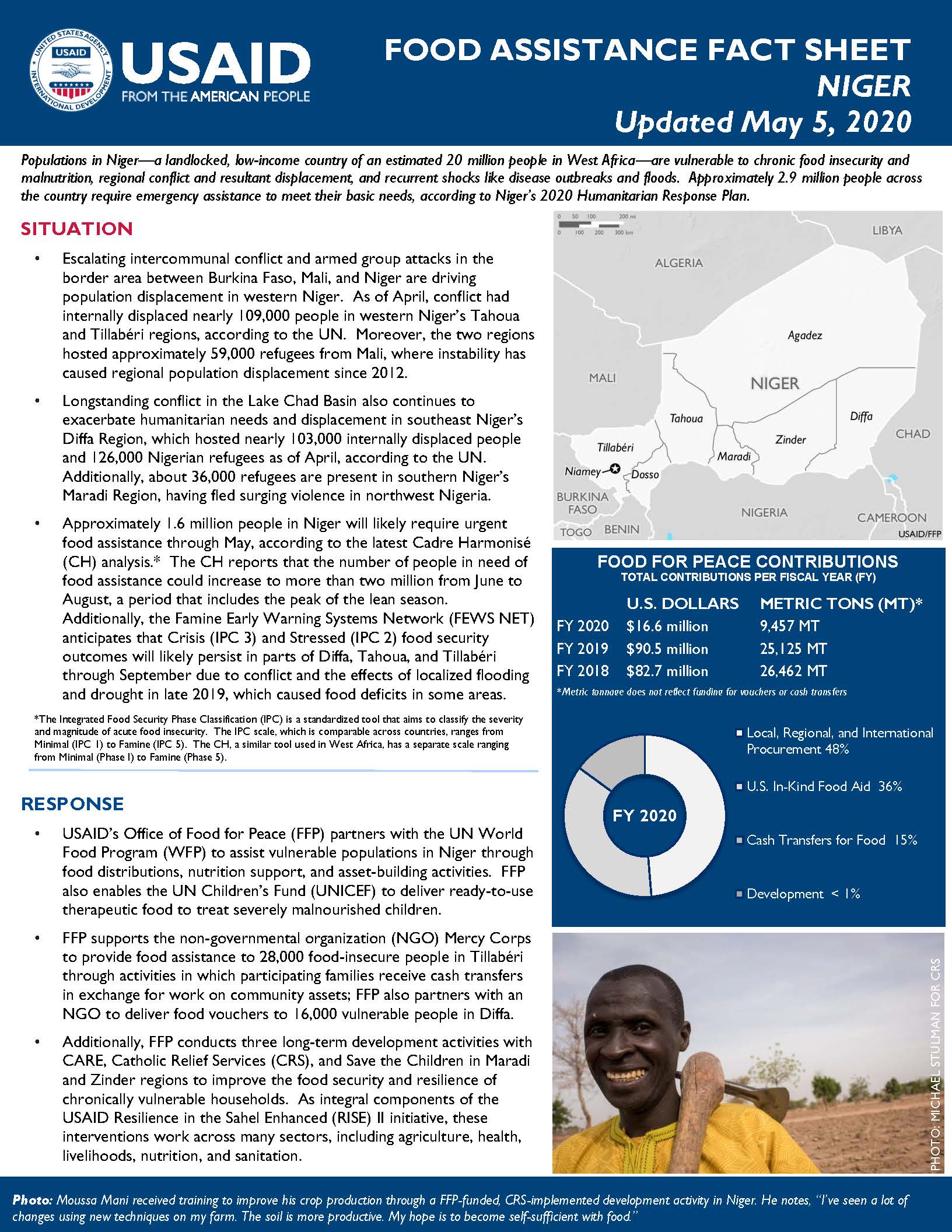- What We Do
- Agriculture and Food Security
- Democracy, Human Rights and Governance
- Economic Growth and Trade
- Education
- Environment and Global Climate Change
- Gender Equality and Women's Empowerment
- Global Health
- Humanitarian Assistance
- Transformation at USAID
- Water and Sanitation
- Working in Crises and Conflict
- U.S. Global Development Lab
Speeches Shim

May 5, 2020
Populations in Niger—a landlocked, low-income country of an estimated 20 million people in West Africa—are vulnerable to chronic food insecurity and malnutrition, regional conflict and resultant displacement, and recurrent shocks like disease outbreaks and floods. Approximately 2.9 million people across the country require emergency assistance to meet their basic needs, according to Niger’s 2020 Humanitarian Response Plan.
Situation
- Escalating intercommunal conflict and armed group attacks in the border area between Burkina Faso, Mali, and Niger are driving population displacement in western Niger. As of April, conflict had internally displaced nearly 109,000 people in western Niger’s Tahoua and Tillabéri regions, according to the UN. Moreover, the two regions hosted approximately 59,000 refugees from Mali, where instability has caused regional population displacement since 2012.
- Longstanding conflict in the Lake Chad Basin also continues to exacerbate humanitarian needs and displacement in southeast Niger’s Diffa Region, which hosted nearly 103,000 internally displaced people and 126,000 Nigerian refugees as of April, according to the UN. Additionally, about 36,000 refugees are present in southern Niger’s Maradi Region, having fled surging violence in northwest Nigeria.
- Approximately 1.6 million people in Niger will likely require urgent food assistance through May, according to the latest Cadre Harmonisé (CH) analysis.* The CH reports that the number of people in need of food assistance could increase to more than two million from June to August, a period that includes the peak of the lean season. Additionally, the Famine Early Warning Systems Network (FEWS NET) anticipates that Crisis (IPC 3) and Stressed (IPC 2) food security outcomes will likely persist in parts of Diffa, Tahoua, and Tillabéri through September due to conflict and the effects of localized flooding and drought in late 2019, which caused food deficits in some areas.
*The Integrated Food Security Phase Classification (IPC) is a standardized tool that aims to classify the severity and magnitude of acute food insecurity. The IPC scale, which is comparable across countries, ranges from Minimal (IPC 1) to Famine (IPC 5). The CH, a similar tool used in West Africa, has a separate scale ranging from Minimal (Phase I) to Famine (Phase 5).
Food Assistance Fact Sheet - Niger ![]() (pdf - 189k)
(pdf - 189k)
Response
- USAID’s Office of Food for Peace (FFP) partners with the UN World Food Program (WFP) to assist vulnerable populations in Niger through food distributions, nutrition support, and asset-building activities. FFP also enables the UN Children’s Fund (UNICEF) to deliver ready-to-use therapeutic food to treat severely malnourished children.
- FFP supports the non-governmental organization (NGO) Mercy Corps to provide food assistance to 28,000 food-insecure people in Tillabéri through activities in which participating families receive cash transfers in exchange for work on community assets; FFP also partners with an NGO to deliver food vouchers to 16,000 vulnerable people in Diffa.
- Additionally, FFP conducts three long-term development activities with CARE, Catholic Relief Services (CRS), and Save the Children in Maradi and Zinder regions to improve the food security and resilience of chronically vulnerable households. As integral components of the USAID Resilience in the Sahel Enhanced (RISE) II initiative, these interventions work across many sectors, including agriculture, health, livelihoods, nutrition, and sanitation.
Food for Peace Contributions
Total Contributions:
| U.S. Dollars | Metric Tons | |
|---|---|---|
| Fiscal Year 2020 | $16.6 million | 9,457 MT |
| Fiscal Year 2019 | $90.5 million | 25,125 MT |
| Fiscal Year 2018 | $82.7 million | 26,462 MT |
* Metric tonnage does not reflect funding for vouchers or cash transfers.
Country Specific Guidance
- Fiscal Year 2018 Niger Country Specific Information
- Final Report: Summative Performance Evaluation of Food for Peace Title II Projects in Niger
- Fiscal Year 2018 Climate Snapshot for Niger
- Food for Peace Food Security Desk Review for Niger, October 2017
- Niger Market Fundamentals Report, October 2017
- West Africa Enhanced Market Analysis, December 2017


Comment
Make a general inquiry or suggest an improvement.